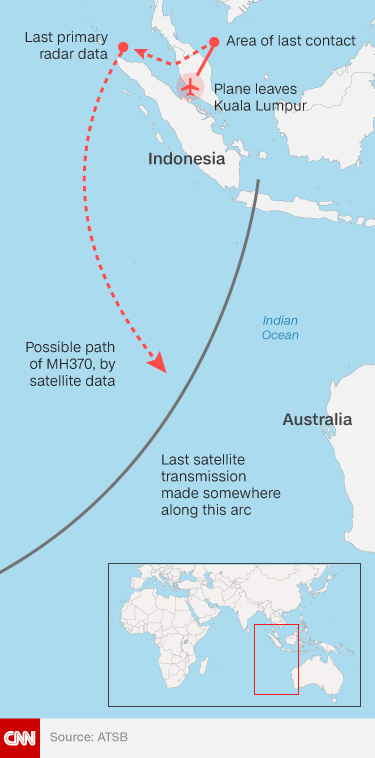Search for MH370: Where is the missing plane?
More clues are emerging about the fate of missing Malaysian Airlines flight MH370, more than two years after the plane disappeared with 239 people on board.
Ocean currents have delivered three pieces of debris, including a flaperon that investigators say indicate no one was in control of the plane when it spiraled at high speed into the sea.
Authorities are meeting in Canberra, Australia, to examine evidence and potentially consider extending the undersea search zone.
"To have not found the aircraft at this stage is frustrating for everyone involved and particularly for the families of the passengers and crew," Australian Transport Minister Darren Chester said in a news conference on Wednesday.
Here's what we know so far.
The plane

At 12:41 a.m. on March 8, Malaysian Airlines Flight 370 departed Kuala Lumpur International Airport for Beijing.
It was heading north but after its last message of "Good night Malaysian Three Seven Zero," it changed course towards the west, according to military radar.
From there, investigators believe it turned south around the edge of Indonesia and across the vast Indian Ocean.
Investigators confirmed in July MH370 captain Zaharie Ahmad Shah had tracked a route deep into the Indian Ocean on his home flight simulator, very similar to the one officials believe the missing plane took.
A new report released in November 2016showed the plane had been spiraling downwards at a rate of almost 300 miles per hour at its last satellite transmission.
But investigators still can't say what caused the crash.
Some theories include a loss of oxygen at altitude, which caused the pilot and passengers to lose consciousness, or a fire on board.
The passengers

Agonizing wait for families of MH370 victims
Grandparents, a newly-graduated engineer, a young couple and a two-year-old boy were among 239 people on board MH370 when it vanished.
Individuals and families from 14 different countries were among those traveling to Beijing on that day, but mostly the crew and passengers were from China and Malaysia.
With no word of their loved ones in more than two years, relatives of the passengers have filed lawsuits against Malaysian Airlines.
In 2016, on the two-year anniversary of the plane's disappearance, a suit was lodged by 12 Chinese families against the company.
The search
As of November 2016, more than 110,000 square kilometers (42,000 square miles) of sea floor had already been searched, without any sign of the plane.
Australia, China and Malaysia agreed in July that if the aircraft was not located by the time 120,000 square kilometers (46,000 square miles) had been covered, the search would be suspended.
Bad weather has slowed progress and the remaining 10,000 square kilometers (3,800 square miles) are not expected to be covered until January or February 2017.
Multiple countries and companies are involved in the search, which is taking place along a defined arc in the Southern Indian Ocean -- where the plane made its last satellite transmission.
The debris
Three pieces of the missing plane found off the coast of Africa have been confirmed as coming from MH370, using specific identification numbers.
The first piece found was a flaperon from the plane's wing, which was discovered on Reunion Island in July 2015, after which came two wing flaps which were discovered in Tanzania and Mauritius, in May and June 2016, respectively.
In November, after analyzing the Tanzanian wreckage, the ATSB determined the wing flaps had been stowed when MH370 crashed, meaning the plane had been out of control.
Six other pieces of wreckage found off the African coast, including Mozambique and South Africa, have been considered by the Australian Transport Safety Bureau as likely coming from the missing plane, although they haven't be confirmed.
In total, 20 piece of debris have been brought to the attention of the investigative team.
The ocean currents
Physical Oceanography Senior Lecturer at Bangor University Mattias Green wrote for CNN that material which enters the ocean southwest of Australia would be carried toward the equator by the West Australia current.
"There it could join the South Equatorial current moving westwards until it joined the Mozambique current traveling along the African coast," he wrote.
But aside from that, O'Neill and Associates aviation expert Peter Goelz said the pieces discovered so far have told us very little about the disappearance of MH370.
"All it tells us is what we suspected, in that the plane crashed somewhere in the South Indian Ocean," he told CNN.
What happens now?
When the underwater investigation finishes, Goelz says the entire search will effectively be over, except for going over old evidence and findings.
"At some time in the future there will be a quantum leap forward in the ability to look underneath the sea and someone will find it. But that's not for decades," he said.
"I think at some point, they'll find it -- it's too big a mystery. But the technology we have now, we can't do it easily or cheaply."
The meeting in Canberra will involve Malaysian, Chinese and Australian officials who will discuss the search.
Even it's suspended, Australian and Malaysian officials have been emphatic that it doesn't mean they're giving up on the missing plane.
News Courtesy: www.cnn.com











